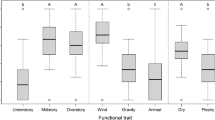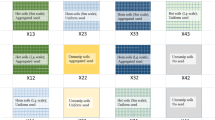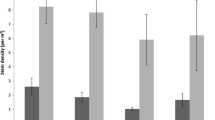Abstract
In order to assess the effects of disturbance on soil seed bank spatial structure, variation in seed bank species composition was analyzed at two spatial scales in mature (undisturbed) and recently disturbed stands of Interior Douglas-fir forest in south-central British Columbia. Coarse-scale analysis among stands 10–100 km apart using Multi-Response Permutation Procedures showed that individual mature stands were mainly characterized by unique seed bank species compositions. Disturbance had an homogenizing effect on seed bank species composition at the coarse scale––there was less variability among stands following disturbance by both low and high severity fires, and by non-salvage logging. In contrast, finer scale analysis among sampling units c. 10 m apart showed that heterogeneity in seed bank species composition was greater on severely burned and logged sites, commensurate with greater levels of soil disturbance, than on lightly burned and undisturbed sites. Despite the high intensity of seed bank sampling (sixty 25 cm2 soil samples from each of 16 sites), species-area curves leveled off only when infrequent species were removed from the dataset. The number of seed bank samples required to account for the common species ranged from 84 on severely burned sites, to 196 on undisturbed sites; more than the 240 samples collected per disturbance class in this study would have been required to account for the remaining infrequent species. Overall, this study highlights the importance of sampling intensively within multiple stands to capture the variation in species composition inherent to these dry coniferous forest soil seed banks.




Similar content being viewed by others
References
Arsenault A, Klenner W (2005) Dry-belt forests in the southern interior of British Columbia: perspectives on historic disturbances and implications for management. In: Lagene L, Zelnik J, Cadwallader S, Hughes B (eds) Mixed severity fire regimes: ecology and management, Spokane WA, 17–19 November 2004. Washington State University Coop Extension Service/The Association for Fire Ecology, Pullman WA. Vol AFE MISC03, pp 105–121
Baskin CC, Baskin JM (1998) Seeds: ecology, biogeography, and evolution of dormancy and germination. Academic Press, San Diego
Bigwood DW, Inouye DW (1988) Spatial pattern analysis of seed banks: an improved method and optimized sampling. Ecology 69:497–507
Bossuyt B, Hermy M (2001) Influence of land use history on seed banks in European temperate forest ecosystems: a review. Ecography 24:225–238
Chambers JC, MacMahon JA (1994) A day in the life of a seed: movements and fates of seeds and their implications for natural and managed systems. Ann Rev Ecol Syst 25:263–292
Clark JS, Macklin E, Wood L (1998) Stages and spatial scales of recruitment limitation in southern Appalachian forests. Ecol Mon 68:213–235
Coffin DP, Lauenroth WK (1989) Spatial and temporal variation in the seed bank of a semiarid grassland. Am J Bot 76:53–58
Greene DF, Johnson EA (1996) Wind dispersal of seeds from a forest into a clearing. Ecology 77:595–609
Greig-Smith P (1964) Quantitative plant ecology. Butterworths, London
Harper JL (1977) Population biology of plants. Academic Press, London
Henderson CB, Petersen KE, Redak RA (1988) Spatial and temporal patterns in the seed bank and vegetation of a desert grassland community. J Ecol 76:717–728
Huggard D, Arsenault A, Vyse A, Klenner W (2005) The Opax Mountain silvicultural systems project: preliminary results for managing complex, dry Interior Douglas-fir forests. BC Min For, Res Br, Victoria, BC, Exten Note 72
Jacquemyn H, Butaye J, Hermy M (2003) Influence of environmental and spatial variables on regional distribution of forest plant species in a fragmented and changing landscape. Ecography 26:768–776
Kershaw KA (1963) Pattern in vegetation and its causality. Ecology 44:377–388
Lee P (2004) The impact of burn intensity from wildfires on seed and vegetative banks, and emergent understory in aspen-dominated boreal forests. Can J Bot 82:1468–1480
Lloyd D, Angove K, Hope G, Thompson C (1990) A guide to site identification and interpretation for the Kamloops Forest Region. British Columbia Ministry of Forests, Victoria
Lortie CJ, Turkington R (2002) The small-scale spatiotemporal pattern of a seed bank in the Negev Desert, Israel. Écoscience 9:407–413
Matlack GR, Good RE (1990) Spatial heterogeneity in the soil seed bank of a mature Coastal Plain forest. Bull Torr Bot Club 11:143–152
McCune B, Mefford MJ (1999) Multivariate analysis of ecological data, version 4.17. MjM Software, Gleneden Beach, Oregon
McCune B, Grace JB, Urban DL (2002) Analysis of ecological communities. MjM Software Design, Gleneden Beach, Oregon
McGee A, Feller MC (1993) Seed banks of forested and disturbed soils in southwestern British Columbia. Can J Bot 71:1574–1583
Morgan P, Neuenschwander LF (1988) Seed-bank contributions to regeneration of shrub species after clear-cutting and burning. Can J Bot 66:169–172
Olano JM, Caballero I, Laskurain NA et al (2002) Seed bank spatial pattern in a temperate secondary forest. J Veg Sci 13:775–784
Qi M, Scarratt JB (1998) Effect of harvesting method on seed bank dynamics in a boreal mixedwood forest in northwestern Ontario. Can J Bot 76:872–883
Reiné R, Chocarro C, Fillat F (2006) Spatial patterns in seed bank and vegetation of semi-natural mountain meadows. Plant Ecol 186:151–160
Shaukat SS, Siddiqui IA (2004) Spatial pattern analysis of seeds of an arable soil seed bank and its relationship with above-ground vegetation in an arid region. J Arid Environ 57:311–327
Stark KE, Arsenault A, Bradfield GE (2006) Soil seed banks and plant community assembly following disturbance by fire and logging in Interior Douglas-fir forests of south-central British Columbia. Can J Bot 84:1548–1560
Takahashi K, Kamitani T (2004) Effect of dispersal capacity on forest plant migration at a landscape scale. J Ecol 92:778–785
Ter Heerdt GNJ, Verweij GL, Bekker RM, Bakker JP (1996) An improved method for seed-bank analysis: seedling emergence after removing the soil by sieving. Funct Ecol 10:144–151
Thompson K (1986) Small-scale heterogeneity in the seed bank of an acidic grassland. J Ecol 74:733–738
Thompson K, Grime JP (1979) Seasonal variation in the seed banks of herbaceous species in ten contrasting habitats. J Ecol 67:893–921
Turnbull LA, Crawley MJ, Rees M (2000) Are plant populations seed-limited? A review of seed sowing experiments. Oikos 88:225–238
Turner MG, Baker WL, Peterson CJ, Peet RK (1998) Factors influencing succession: lessons from large, infrequent natural disturbances. Ecosystems 1:511–523
Warr SJ, Thompson K, Kent M (1993) Seed banks as a neglected area of biogeographic research: a review of literature and sampling techniques. Prog Phys Geogr 17:329–247
Acknowledgments
We are grateful to Amanda Bond for assistance in the field and greenhouse, and to David Williams and Kevin Scollon for providing greenhouse space and logistical support. Funding for this project was provided by Forest Innovation Investment, Forest Investment Account (Forest Science Program), the BC Forest Service, and a Natural Sciences and Engineering Research Council (NSERC) post-graduate scholarship to Kaeli E. Stark.
Author information
Authors and Affiliations
Corresponding author
Rights and permissions
About this article
Cite this article
Stark, K.E., Arsenault, A. & Bradfield, G.E. Variation in soil seed bank species composition of a dry coniferous forest: spatial scale and sampling considerations. Plant Ecol 197, 173–181 (2008). https://doi.org/10.1007/s11258-007-9368-8
Received:
Accepted:
Published:
Issue Date:
DOI: https://doi.org/10.1007/s11258-007-9368-8




